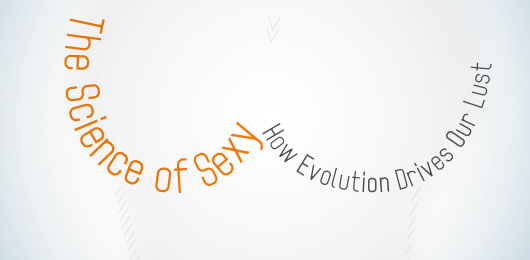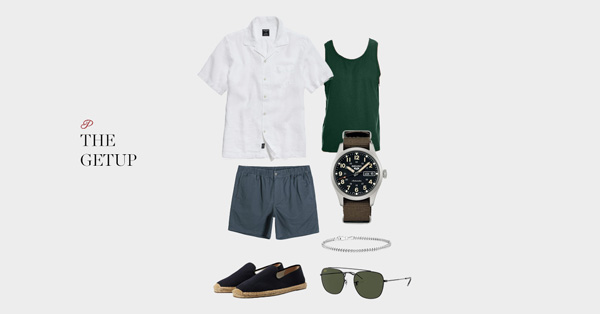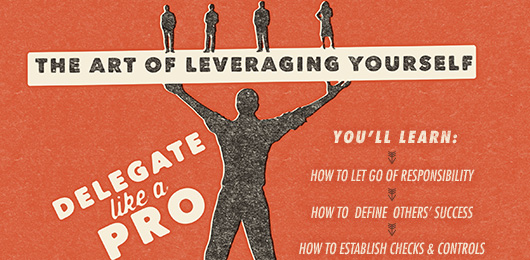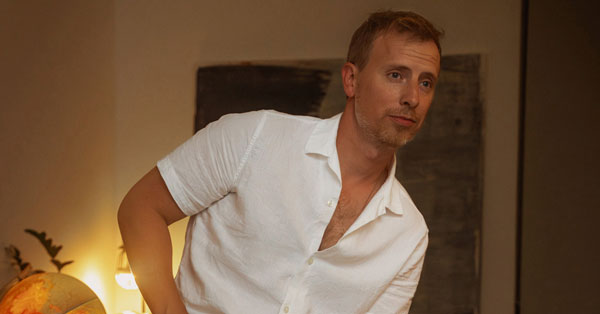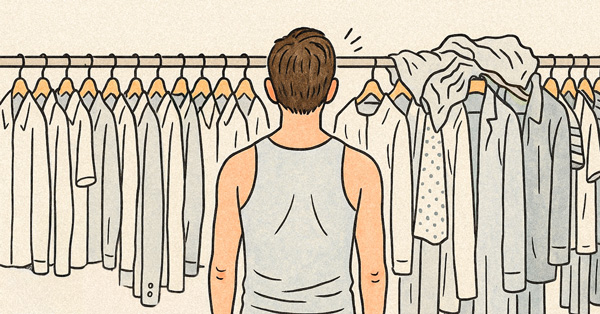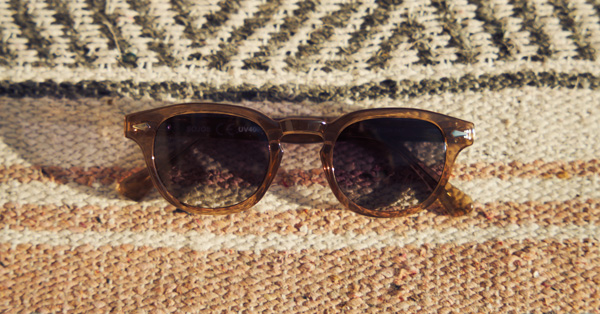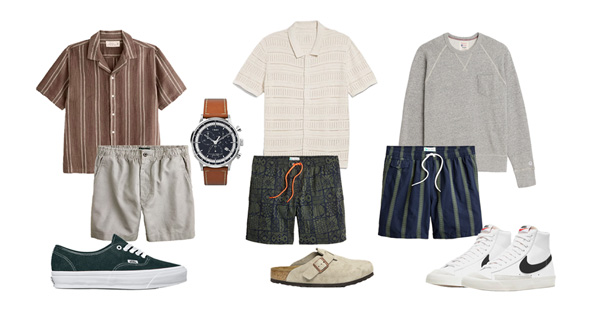No matter how civilized and urbane you may believe you are, there are certain primal urges that you undoubtedly share with your hairy-knuckled ancestors. (That is, if you believe in all that evolution jazz. If not, you should just stop reading now and hang out with that guy who's all “Bueller…Bueller…Bueller.”)
Even James Bond acts on instinct while bedding buxom beauties from beyond the British border – and he wears a suit most of the time. Although he's spent years refining his distinguished taste for shaken martinis, many factors contributing to his taste in women were simply handed down through evolution – just like yours.
Here are a few ways that our notion of sex appeal is hardwired into our systems:
Eyes
Let's say you are a gentleman, and when asked, “What's the first thing that attracted you to her?” you answer, tactfully: “Her eyes.” Eyes, we all know, are the windows to the soul, and this is what we are attempting to say when we lie about love at first sight. Rather than admit that you were initially stirred from across the bar by more animal lusts, it is nicer for everyone to believe that your connection was built on soulful insight. But there may be more truth to that than you realize.
Much of the important communication between humans is neither verbal nor even conscious. When chatting about jobs, hometowns and hobbies, the question we are really asking is simply “Can I trust you?” True, finding out someone makes their living by stealing identities may be a game changer, but for the most part, the answers to small-talk questions themselves don't help us reach this conclusion nearly as much as the manner in which they are answered. Our face-to-face interactions are more about reading the subtle cues – fidgeting hands, shifty eyes, pursed lips – than parsing the meanings of words. It's what Steven B. Johnson, author of “Mind Wide Open” calls “mind sight.” From a New York Times review of the book:
Even before we can talk, almost all of us know how to read subtle hints in the faces, voices and gestures of the people who hover around our cribs. That is, we can do by instinct what neuroscientists are just learning to do with scanners and monitors. […] Our innate ability to read people's faces is outside conscious thought. As with breathing or swallowing, we can't explain how we do it.
Eyes are the main event in a one-on-one mind reading session. And we tend to like them big and open, with long lashes and steady, yet responsive, gazes. Those with beady eyes or dodgy glances come off – sometimes wrongly – as hard to read, and therefore, perhaps untrustworthy. Someone you can't read is someone you can't trust which is decidedly unsexy. Unless, of course, mystery is your thing. But in the grand scheme of reproduction – the whole point of this mating ritual – feeling like a person is honest and reliable will be an important feature when choosing a potential parent of your offspring.
Exoticness and Genetic Diversity
A lot of the criteria described herein hinges upon the advantage of genetic diversity. Essentially, this means that in order to survive a changing environment, a species must adapt. And the adaption of a population relies upon individuals choosing genetically dissimilar mates. For the purpose of this article, that's all you need to know and you can skip the next paragraph if you don't want to hear any more evolutionary gibbly goop.
The opposite of biologically diverse would be a monoculture, which is most identifiable (and problematic) in agriculture. Monocultures are susceptible to disease, because if one plant contracts it, it will quickly spread throughout the population which is comprised of identically vulnerable plants. For a human example, take the case of sickle cell anemia and malaria in West Africa. In this situation, there were three types of genetic makeups: those with two copies of genes mutated for sickle cell anemia, those with one sickle-cell gene, and those with no sickle cell genes. The first group suffered from sickle cell but was immune to malaria, and the third group succumbed to malaria but had no symptoms of sickle cell anemia. Meanwhile, the second group was immune to malaria but had low enough symptoms from sickle cell anemia that they survived. If the first group and the third group would have never mingled, then the second group wouldn't have existed to carry on. So, it all comes back to that first rule of investing: diversify.
In spite of all these scientific studies, chances are you don't go out on the town with genetic diversity on your mind (“Dude, get a load of that honey, she is mad genetically dissimilar to me. Mm!”). But there are ways that our sexual proclivities nudge us towards novel genes. For instance, consider accents. Every guy has his favorite sexy accent – be it the staid British intonations of Keira Knightley, the fiery Latina syllables of Shakira, or the French phonology of Audrey Tautou. The likely reason why exoticism is a turn-on? Simple – if a woman hails from a faraway land, you can bet that she comes from a drastically different gene pool than you. Plus, if a parent is a world-traveler, there's a better chance that little versions of you will begin popping up on further corners of the globe.

- Photo by Irvin A Kelly
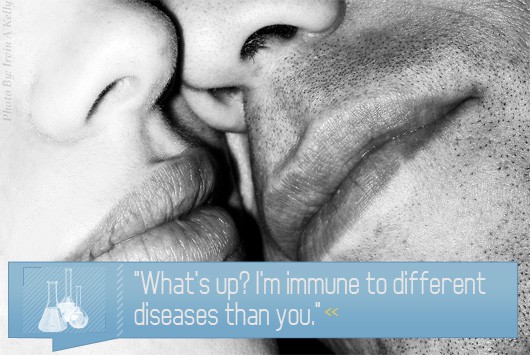
Scent
As dirty, stinky human beings, we spend a lot of time trying to mask our natural odor. But in reality, it plays an important role in attracting a mate. Although our faculties for communicating through scent aren't nearly as refined as those of say, a dog or an ant, our bodies send certain signals to the bodies of those of the opposite sex regarding our availability and effectiveness as a mate. Often times, these messages contain information that we aren't even aware of, such as:
- “Hey, I'm really, really fertile right now.”
- “You know, I'm not your regular boyfriend, and I'm probably not going to take care of your kid.”
- “What's up? I'm immune to different diseases than you.”
According to Elizabeth Svoboda, writing for Psychology Today, “Scent-based cues help us zero in on optimal partners – the ones most likely to stay faithful to us and to create healthy children with us.” For example, Swiss scientists had 49 women judge the attractiveness of several men based only on their sweaty t-shirts, and it turns out that they preferred the odor of men who were “immunologically dissimilar to them,” meaning that their children would, in turn, have greater immunities. (It'd be like if Aquaman and Storm from X-Men hooked up, their kid could talk to the fishes and control the weather. Which, I suppose, would make him more popular at school.) So, while finding the love of your life may not be as easy as finding a bowl of Froot Loops, for both, it appears that you can start by following your nose.
The Hourglass Figure
While the fashion runway continually endeavors to skew the ideal body-type (typically towards the skeletal), the most classic epitome of female beauty is the hourglass figure. What does that mean? Busty on top, slim in the middle and broad in the hips. Let's break this down from top to bottom:
Breasts
There is a near consensus among males that large breasts are sexually attractive – in fact, some are downright religious regarding this preference. Why, though, is a little bit more contentious subject. We all know what function breasts serve in child rearing, but the efficacy of breast milk production has little to no correlation with size. This thread on an evolutionary psychology forum explores a few theories on why busty women are often the life o' the party:
- Large breasts are a nice backup for fat storage, meaning better chance for survival in case of famine. (Like a camel's hump!?)
- Desmond Morris' book, “The Naked Ape,” was cited in this article on automimicry which posited that cleavage mimics the “rump,” which we are accustomed to viewing when “mounting from behind in the ancestral way,” though now we “go about it face to face.”
- Symmetrical breasts indicate “good genetic diversity” and “little exposure to disease,” per an article entitled “Titalizing Tits.”
- From the same article, breasts tend to “swell up” during ovulation, signaling fertility.
Waist-to-hip ratio
When rating women on a scale of one to 10, it turns out that European-minded fellows tend to prefer a 0.7, at least as far as waist-to-hip ratio (WHR) goes. That means that the waist circumference is 70 percent of the hip circumference. Famous 0.7's include:
So what's the deal with hip ladies? Again, it leads back to fertility. From the British Journal of Psychology in May 2001:
For shape in women, research has focused on the ratio of the width of the waist to the width of the hips (the waist-hip ratio, or WHR). A low WHR (i.e. a curvaceous body) is believed to correspond to the optimal fat distribution for high fertility, and so this shape should be highly attractive.
And we've all heard the term “child bearing hips.” According to the Daily Mail in November 2008, a wide pelvis is needed to ensure that our bulbous skulls chock-full of immense intellect didn't get stuck on our way out of the womb. Per the article, our first ancestor to start accommodating our big brains with child bearing hips was, coincidentally, the first human predecessor to figure out how to use tools and get the hell out of Africa: homo erectus.
So there you have it: big boobs, wide hips = baby geniuses…theoretically.
A Healthy Vessel
Harking back to the crass comparison of breasts to camel's humps (apologies, ladies, you know we respect you more than that, it's just the evolution talking), one of the sexiest features a human can flaunt is good health. Here are some strong indicators of a sexy specimen:
- Glossy, evenly colored fingernails. Tamra Lior, a dermatologist cited on WebMd, says, “Just like the eyes are the window to the soul, so are the nails.” According to the article, bad nails can be a sign of heart disease, hepatitis, fungal infections, iron deficiency and lupus, to name a few. Totally unsexy.
- Long, shiny, thick hair. Miss Model Behavior, a former model claims in an interview:
- Long hair can showcase one's health history… Long hair's also a sign of youth and fertility. One of the ways in which hair subconsciously plays a role in sexual attraction is through pheromones. These secretions, some of which are released from hair follicles, help determine whether two people are sexually compatible with each other.
- A nice smile. According to Journal of American Dental Association, “Malnutrition, specifically insufficient vitamin supply, has been shown to induce oral disease.” The article also notes that periodontal disease often leads to birth complications.
- Muscle tone. Shapely legs and thighs and tight buttocks are better suited to helping you escape from a predatory lion than wet noodle limbs. We weren't always on top of the food chain, you know.
- Sun tans. A study in the Journal of Applied Social Psychology showed that “a medium tan is perceived as healthiest and most attractive, and ‘no tan' is perceived as both least healthy and attractive,” much to the chagrin of the Skin Cancer Foundation. Interestingly, though, society used to favor fair-skinned maidens, as it proved that they spent all their time indoors, rather than toiling in the hot sun.
Virginity and Relative Youth
Men typically, and sometimes creepily, prefer women who exude an air of innocence and, in some cases (Hugh Hefner and Michael Douglas) choose mates who are much, much younger than them. Why? The allure of youthful unworldliness are twofold:
Sexual Jealousy
It's not just American men who are obsessed with virginity – it plays an important role in nearly all cultures and religions. The preoccupations with chastity across cultures is beyond the scope of this article, but the reason for men preferring the inexperienced is easy to understand: simple jealousy.
We as humans typically prefer our relationships to be monogamous ones and desiring virginity is just an extension of that: rather than being someone's exclusive lover for the time-being, it's an ego-stroking fantasy to believe that someone is your exclusive mate for all time. But jealousy also plays an important role in perpetuating your lineage (which is the name of the game, as far as evolution goes). Women can only carry one child at a time – and the competitive male's prerogative is ensuring that it is always his. Being the one and only naturally makes a man feel satisfied and dominant.
Fertility Cues
Younger women naturally exhibit many of the indicators of good health discussed above. In short, a younger woman is simply a better candidate for carrying a child than an older woman. Doctors opine that fertility peaks in the early 20s and declines beginning at 30, with the obvious end being menopause. (Though, of course, this is only a physical measure – as the long term health of the population improves and both young men and women increasingly focus on careers in their 20s, having children after 30 is becoming more common.)
Is Sexy Obsolete?
By now, you may be thinking, “Whoa, buddy, I just wanted to get laid. None of this fertility noise applies to my lifestyle.” That's a good point. We don't dance in clubs and flirt in bars solely with babies on the mind. And with today's modern medicine and better nutrition, it seems like selecting mates based on criteria better suited to the wilderness seems especially irrelevant. We are no longer giving birth in caves, wrestling hyenas away from the den and fending off diseases with nothing but our constitution. Protecting your children in this day and age is more about paying for health insurance and baby-proofing the medicine cabinet.
But adaptation moves slowly. Consider this: humans as we know them have been around for the last 130,000 years, but penicillin was discovered less than a century ago. This life of leisure is still relatively new, and we are unlikely to shake our old habits of selecting mates and dates based on physical attributes anytime soon. I'm not going to say anything as trite as “true beauty is on the inside,” but knowing where our fetishes stem from makes it a lot easier to give our primal urges less clout.



